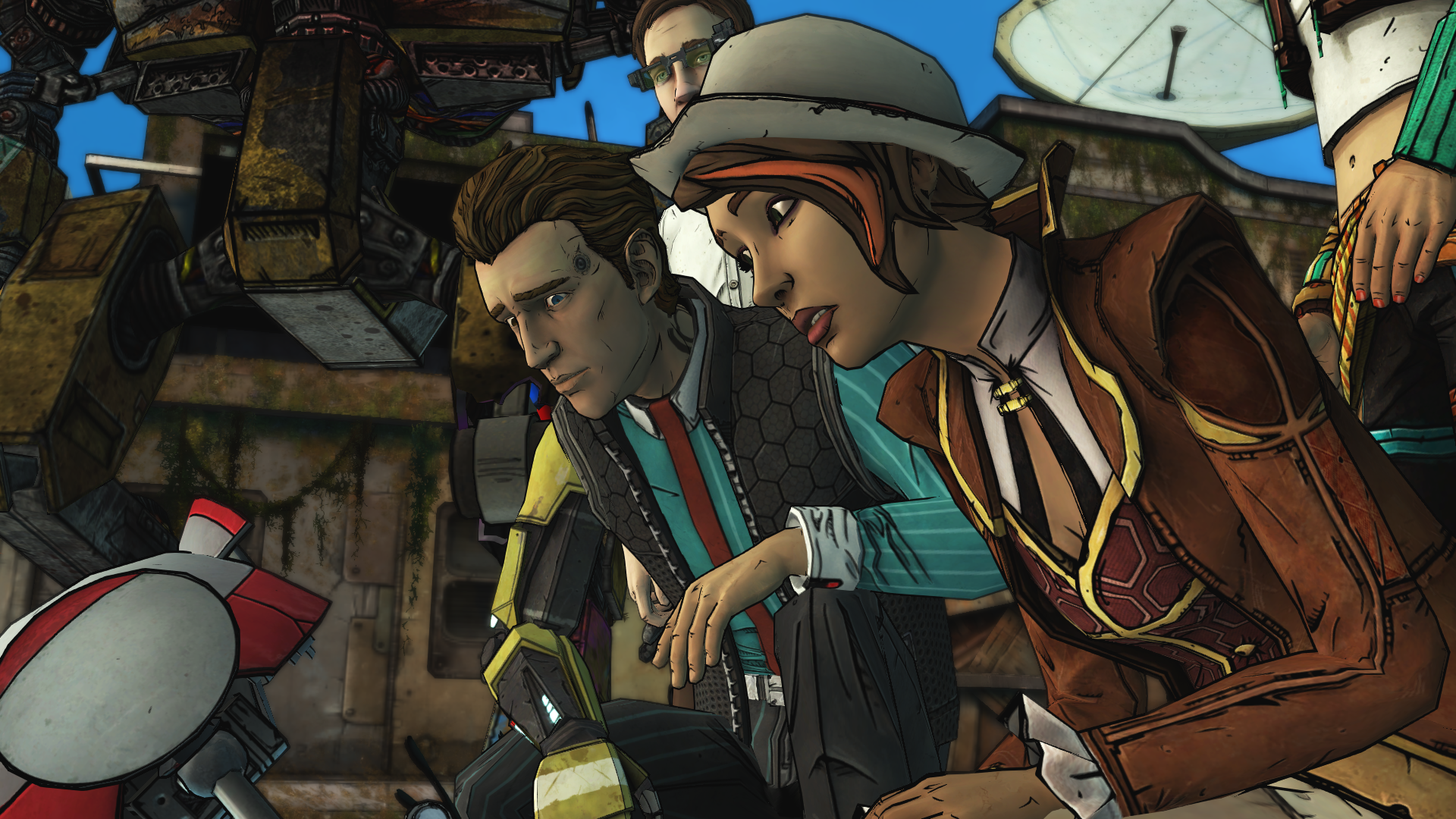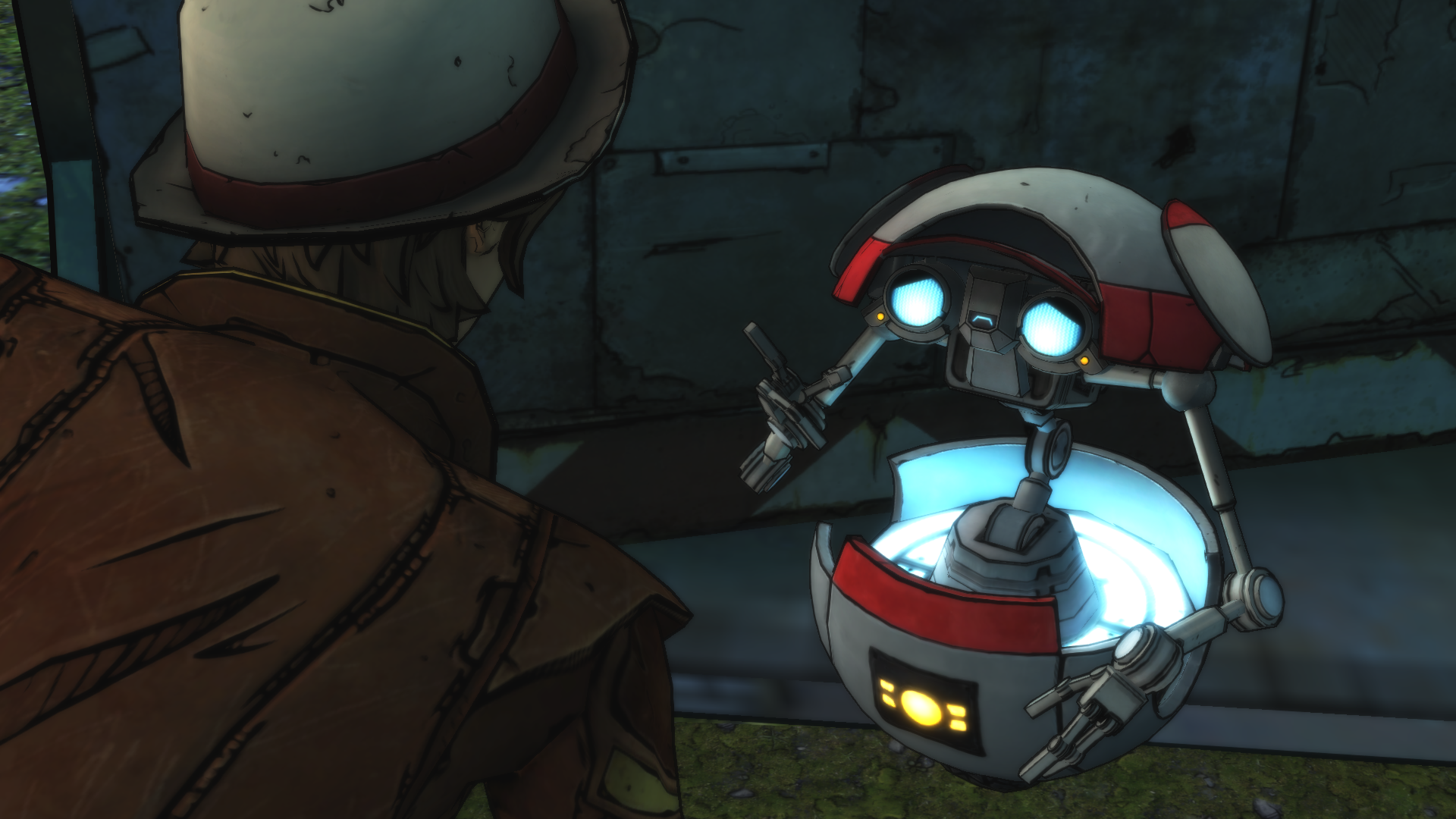Tales from the Borderlands: Episode Three - Catch a Ride review

You can’t buy Telltale’s episodic adventures one episode at a time on PC—you’re buying all five in the season for $25/£20—so it doesn’t make much sense for us to score each one individually. We’ll review and score the whole package when all the episodes have been released, while individual episode reviews like this one will be unscored criticism and recaps.
Spoiler warning: I've tried to keep spoilers to a minimum, but there are a few plot details here, especially from previous episodes. If you'd rather experience it totally fresh, back out now.
Most games are really just about going for a nice walk, except there's stuff in the way. Like Doom. It's just a pleasant stroll with a bunch of stupid demons and locked doors ruining everything. In adventure games, the barrier to progress has typically been puzzles, but Telltale has almost entirely ditched those in favor of dialogue and plot, and for the most part, that's been working great. Tales from the Borderlands is my favorite game from them so far. (Here's my review of episode one if you're not caught up.)
When Telltale uses barriers outside of dialogue, though, I don't find them very fun. Mashing Q isn't a meaningful way to interact, just an annoying one (to me, and to whoever's sharing a room with me and my mechanical keyboard). Clicking on red targets during action scenes isn't much better, and was obviously made with controllers in mind. Transitions between scenes sometimes stutter, and some of the camera angles are a pain to deal with. Movement is still awkward as hell, and when I walk around looking for a solution, only to find that the solution is 'look at everything,' I'm disappointed that I didn't get a chance to figure anything out on my own. I can sense how little it wants to challenge me—so little that it seems pointless to include anything but dialogue and plot.
In Tales from the Borderlands' third episode, Telltale does something I like in regard to action. During a couple of scenes, Fiona visualizes two possible courses of action, and we pick one. The slight, ultimately meaningless, addition at least acknowledges that decision-making is what's fun about Tales from the Borderlands, not the chore of clicking red targets (which there's still lots of), but I want to see more, bolder experiments. The action scenes are exciting, but the choices aren't hard and rarely do much to the outcome.
I appreciate what a big challenge it must be to design action, though, and that animating some huge array of outcomes is probably unrealistic (I haven't posed it as a problem because I know how to solve it). And as I said, I love Tales from the Borderlands so far. The writing has been great, and the third episode is my favorite. It's dense, covering a lot of ground while still giving us slow moments for some good character development. It's also the funniest episode, and it introduces a bunch of new characters (including an adorable, non-annoying, non-Claptrap robot).

The only story aspect I'm not fond of is the Handsome Jack subplot. Having his maniacal laughter and 1950s-era sexism secretly living in Rhys' head is one of those old tropes I've never been fond of: good character is possessed by a cad, misunderstandings with friends ensue. I don't really understand why people like Jack so much, but he's popular (I told someone I didn't like him and she thinks less of me now, like, as a person) so I can't blame Telltale for resurrecting him.
At least his involvement depends a little bit on what happens at the end of episode two. Telltale told me that I'd have "a significantly different experience" depending on who I trusted in that episode, so I played episode three both ways. The first bit does play out entirely differently depending on your choice, but after that's over you get the same basic outcome. The only major difference is that a character in the 'trusted Fiona' timeline has to sit out of some growth, and Jack has a bit less power unless you give in to him, so you'll skip a scene I didn't like much anyway. Oh, and the 'trusted Jack' timeline gets you a small extra something I did like, but isn't major. As usual, it seems both timelines are leading to the same place, and I don't actually recommend replaying episodes—it ruins some of the illusion.
The biggest gaming news, reviews and hardware deals
Keep up to date with the most important stories and the best deals, as picked by the PC Gamer team.
If you do replay it, it might be to spend a little more time in one of this episode's destinations, somewhere unusually pretty for the wasteland. It looks great, even though the engine is a little clunky: there's the stuttering I mentioned, a few blurry textures, and some long, weird pauses in dialogue. It also likes to cut to a loading screen right after major events. That's all forgivable, as is the rote action, when the humor and characters are as good as they are. At this point, the only caveat I have when recommending TFTB is that I have no idea how long it'll be before the final two episodes are out (three to four months between episodes seems to be the pace).

Tyler grew up in Silicon Valley during the '80s and '90s, playing games like Zork and Arkanoid on early PCs. He was later captivated by Myst, SimCity, Civilization, Command & Conquer, all the shooters they call "boomer shooters" now, and PS1 classic Bushido Blade (that's right: he had Bleem!). Tyler joined PC Gamer in 2011, and today he's focused on the site's news coverage. His hobbies include amateur boxing and adding to his 1,200-plus hours in Rocket League.

